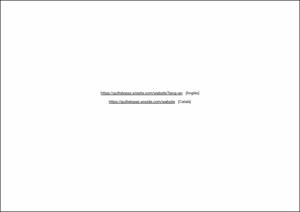Mostra el registre d'ítem simple
Architecture and ceramics, hand in hand
| dc.contributor | Peñín Llobell, Alberto |
| dc.contributor | Arranz, Félix |
| dc.contributor | González Barroso, José M. |
| dc.contributor | Onecha Pérez, Ana Belén |
| dc.contributor.author | López Garulo, Guifré |
| dc.coverage.spatial | east=51.6659656; north=32.6538966; name=Isfahan Province, Isfahan, Shams Abadi St, Iran |
| dc.date.accessioned | 2020-04-14T13:12:36Z |
| dc.date.available | 2020-04-14T13:12:36Z |
| dc.date.issued | 2020-02-10 |
| dc.identifier.uri | http://hdl.handle.net/2117/183354 |
| dc.description.abstract | The purpose of this document is to gather architectural research together with ceramics as the main focus. It aims to synthesize the work done in the field of ceramics in three specific scenarios within the wide range of possible applications of this material in architecture. It should be emphasized that the framework of the document is to respond to a personal search, always with an architectural drift, from a constructive and decorative perspective, drawing a necessary path with an process of testing and learning. The motivation behind this TFG is to discover a possible personal architectural stance with ceramics. I am from both Aragonese and Catalan origin with a common denominator: clay soil. Customs that until very recently was total but still very present, everyday and construction are related to ceramics. Be it a pitcher or a brick, it has been present since I became aware. A long time ago, I read a quote by Antoni Cumella, a Catalan ceramist related to the world of architecture, in which he compared a glass to a building justifying that ‘both have an interior and exterior space, a color, a texture and, of course, a particular use’. Clay is a basic material of ceramics and one of the most used, abundant knwon since the dawn of humanity, together with wood and stone. It has been used with various degrees of intensity, despite technological advances, to the present day, when it is currently in a stage of redefinition. It is true that the ceramics are treated with ancient and modest techniques, almost until the intervention of artificial intelligence, with counted advances but always remaining unchanged. This fact, in my opinion, makes the ceramics a high-tech material. This technological vision is based on the fact that the ceramics has endless desirable characteristics like thermal, structural, decorative, environmental ... among others, always with well-known aptitude and competence, being a very abundant and workable material. We can realize that at any age, it has played a key role, no matter the weather or the latitude. The emergence of other materials, such as concrete or steel, left the ceramic in the background. This usually happens as new techniques, materials, or simply modes change are discovered. However, a new technical revolution can be initiated by looking back to remember and rediscover a solution that was surely forgotten. With all that said, I will focus, as I mentioned at the beginning, on three different but interrelated scenarios where the ceramics are applied in architecture. Isfahan, the site of a decorative technical revolution. Eladio Dieste, an innovative construction solution for reinforced ceramics. Finally, Friedensreich Hundertwasser, an extraordinary sensibility in functional organic representation. Each one of them is confronted by placing the context and the technique with each application in each of them. The choice of scenarios, a personal journey through time and my experiences, which I intend can give reasons and emotions of particular and general order. |
| dc.language.iso | eng |
| dc.publisher | Universitat Politècnica de Catalunya |
| dc.rights | Attribution-NonCommercial-NoDerivs 3.0 Spain |
| dc.rights.uri | http://creativecommons.org/licenses/by-nc-nd/3.0/es/ |
| dc.subject | Àrees temàtiques de la UPC::Edificació::Materials de construcció::Materials ceràmics de construcció |
| dc.subject | Àrees temàtiques de la UPC::Arquitectura::Arquitectes |
| dc.subject.lcsh | Ceramics in architecture |
| dc.subject.lcsh | Pottery -- Iran -- Isfahan |
| dc.subject.lcsh | Dieste, Eladio, 1917-2000 |
| dc.subject.lcsh | Hundertwasser, Friedensreich, 1928-2000 |
| dc.subject.other | Architecture |
| dc.subject.other | Ceramics |
| dc.title | Architecture and ceramics, hand in hand |
| dc.type | Bachelor thesis |
| dc.subject.lemac | Ceràmica en l'arquitectura |
| dc.subject.lemac | Ceràmica -- Iran -- Isfahan |
| dc.subject.lemac | Dieste, Eladio, -- 1917-2000 |
| dc.subject.lemac | Hundertwasser, Friedensreich, -- 1928-2000 |
| dc.identifier.slug | PRISMA-143678 |
| dc.rights.access | Open Access |
| dc.date.updated | 2020-03-30T09:02:12Z |
| dc.audience.educationlevel | Grau |
| dc.audience.mediator | Escola Tècnica Superior d'Arquitectura de Barcelona |
| dc.audience.degree | GRAU EN ESTUDIS D'ARQUITECTURA (Pla 2014) |


